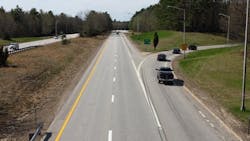Just north of Concord, N.H., both the north- and southbound lanes of I-93 needed pavement rehabilitation.
Extensive cracking and pavement deterioration extended to the pavement base in the right lanes of both the north- and southbound sides.
The solution needed to be long-lasting and able to meet the demands of traffic, as well as New Hampshire’s winter weather and spring freeze-thaw cycle.
The New Hampshire Department of Transportation (NHDOT) identified two distinct longitudinal cracks running the length of the section, one in each of the two right-lane wheel paths, and in some areas of the pavement, a third crack running between the wheel paths. Transverse thermal cracking also was present; however, the longitudinal cracking was much more severe. Coring of the roadway revealed that the majority of the cracking stretched down to the full depth of the structure, extending at times through the base. In some areas, the wearing course had completely worn away and exposed the underlying binder layer, thus creating a significant safety hazard.
Typical roadway rehabilitations involve a simple mill and overlay. However, for severely cracked pavements, a more extensive solution is necessary. In addition, such extensive cracking can result in reflective cracking—the spread of existing cracks from old or existing pavement into the new overlay. Reflective cracking is caused by stresses on the asphalt layer created by traffic loads, changes in temperature, unstabilized subgrade soils and other similar pressures. Thicker overlays or reconstruction are common approaches for dealing with full-depth high-severity cracking, but both methods can be very expensive. Due to the high costs, thicker overlays and reconstruction were both ruled out as viable solutions.
The left and right lanes of both the north- and southbound sections were milled and repaved. To reinforce the pavement and to provide protection against cracking, GlasGrid 8502, a high-modulus fiberglass asphalt pavement interlayer, was placed between two layers of asphalt pavement in the right lanes of the north- and southbound sections. An interlayer helps properly distribute the traffic loads, reinforces the cracked base course and prevents any cracking stemming from prior segregation from reflecting back to the surface. Without an interlayer, these stresses will quickly spread to the surface as reflective cracks. The GlasGrid system intercepts these tensile stresses, extending the performance life of the pavement.
The rehabilitation project took place in 2006, and a review of the site occurred during the summer of 2014. More than eight years after the rehabilitation, the sections of the road containing the GlasGrid 8502 remain in excellent condition.



